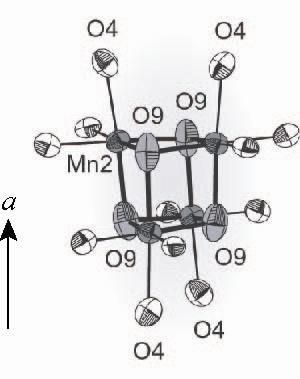
Gifu Prefectural Ceramics Research Institute* Ceramics Research Laboratory, Nagoya Institute of Technology**
○Kenji Tateishi* Nobuo Ishizawa**
Crystals of LiMn2O4 undergo a first order structural phase transition near the room temperature. The high temperature (HT) form adopts a normal spinel-type structure (cubic, Fd-3m) with the octahedral sites populated statistically with heterovalent MnIII and MnIV in the equal ratio. The low temperature (LT) form adopts a 3×3×1 superstructure (orthorhombic, Fddd) with respect to the HT form, containing Mn1III, Mn3III, Mn4IV, Mn5IV and intervalent Mn2 atoms. The synchrotron X-ray single-crystal electron-density analysis revealed a large anisotropy of the atomic displacement parameters of the O9 amd O4 atoms. This suggests an occurrence of the bond-length fluctuation along the pseudo-tetragonal Jahn-Teller distortion parallel to the a axis in the heterocubane Mn24O94 cluster which presumably shares three electrons among four e-parentage orbitals of Mn2 and behaves as a core of Zener-type polaron. The heterocubane Mn24O94 clusters are isolated with each other and embedded in an ordered way in the charge-ordered matrix containing Mn1III, Mn3III, Mn4IV and Mn5IV. The transition between the LT and HT forms of LiMn2O4 can thus be regarded as an order-disorder transition of the Zener-type polarons.
